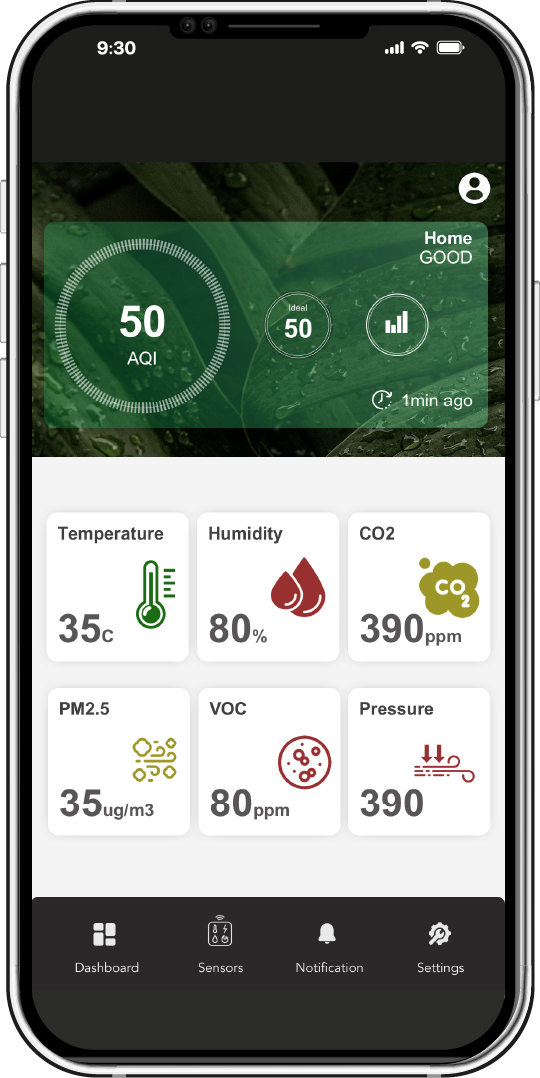
Compact Design
20 hours
Battery Backup
Wifi/GSM
enabled

Compact
Design
20 hours
Battery Backup
Wifi/GSM
enabled
Sensiable sensiAIR
When the air you breathe matters
You can lower the likelihood of indoor health issues by being aware of typical pollutants in your building and knowing the quality of air you breathe. The indoor air contaminants might have an immediate negative impact on health or may take years to manifest. This is why it’s crucial to start keeping an eye on your building’s interior air quality so you can lower these hazards. Good indoor air quality also improves comfort and cognitive performance for the staff members in addition to risk reduction.
You can discover the root of potential air quality problems with the help of real-time data provided by indoor air quality monitoring systems. Your HVAC systems and energy use can be optimised using this data, improving the working environment for your staff.
Minimal, elegant style
We only utilize the best, most dependable components and manufacture with precision to ensure that you can rely on our sensors today, tomorrow and into the future.

Minimal, elegant style

We only utilize the best, most dependable components and manufacture with precision to ensure that you can rely on our sensors today, tomorrow and into the future.
Important parameters for air Quality monitoring
Particulate matter PM2.5
What is it ?
Airborne particles with a diameter of 0.1 to 2.5 micrometers. The widths of the bigger particles in the PM2.5 size range would be around thirty times smaller than the width of a human hair. It may also contain dust, allergens like pollen and mould, soot, combustion byproducts, smoke from fossil fuels, cigarette smoke, and more.
What are its effects ?
Inhaling PM2.5 irritants can aggravate allergies, asthma, respiratory inflammation, and heart and lung diseases. After prolonged exposure, they may develop carcinogenic properties, raising the risk of mortality.


Total volatile organic compound (TVOC)
What is it ?
A class of substances having a high vapour pressure and little water solubility are known as volatile organic compounds (VOCs). Since there are so many VOCs, it is impossible to regularly monitor them all. To gauge the overall concentration of VOCs in a place, a measurement known as TVOC was adopted.
Products like paints and varnishes, cleaning and disinfection supplies, cosmetics, and products including building materials all release VOCs as gases. Generally speaking, concentration is up to ten times higher indoors than outdoors.
What are its effects ?
May irritate the eyes, nose, and throat, induce headaches, dizziness, and nausea, as well as harm the liver, kidneys, and the nervous system. It may cause cancer and have other unidentified short- and long-term negative consequences.
Carbon dioxide (CO2)
What is it ?
A odourless, colourless gas that is created through the burning of organic and carbon compounds as well as during respiration. Insufficient ventilation is the primary cause of CO2 build-up.
What are its effects ?
Lack of attention, headaches, nausea, blurred vision, hearing impairment, and even unconsciousness may result from high levels.
Humidity
What is it ?
Humidity is the amount of water vapor in the air.
What are its effects ?
Increased concentrations could promote the growth of too much bacteria, fungus, and mould. Reduced levels may worsen allergic reactions, produce itchy eyes, breathing problems, and skin and respiratory disorders.
Temperature
What is it ?
A comfortable indoor temperature is referred to as room temperature, and it is typically between 20 and 25 °C (68 and 77 °F). The ideal temperature is one where people can comfortably wear everyday attire.
What are its effects ?
High temperatures and temperature variations harm health. Unstable temperatures harm the cardiovascular and immune system, and are associated with an increase of mortality


Download the mobile app
The Air Quality sensor’s handy smartphone app makes it easy to check the air quality at your home or place of business before you arrive.
The sensiAIR Smart Indoor Air Quality app offers details on PM2.5, CO2, and VOC levels.
Along with monitoring interior humidity and temperature, it works seamlessly with iOS and android operating systems. In your house or place of business, you can set up separate monitoring stations and monitor them all through a single app.
Whatever you need to do to monitor air quality, the sensiAIR app can help!
Air Quality – Recommended Values
INDICATOR
Good
Moderate
Unhealthy
Detection Range
PM2.5
0 µg/m3 to 79 µg/m3
80 µg/m3 to 199 µg/m3
≥ 200 µg/m3
-
TVOC
<0.03 ppm
-
>0.38 ppm
0.12 ppm to 0.99 ppm
Co2
<1000 ppm
-
>1000 ppm
400 ppm to 2000 ppm
HUMIDITY
-
-
-
0% to 100%
TEMPERATURE
-
-
-
10°C to 40°C. [50°F to 104°F]
Air Quality – Recommended Values
Good
PM2.5
0 µg/m3 to 79 µg/m3
Moderate
PM2.5
80 µg/m3 to 199 µg/m3
Unhealthy
PM2.5
≥ 200 µg/m3
Detection~
PM2.5
-
TVOC
<0.03 ppm
TVOC
-
TVOC
>0.38 ppm
TVOC
0.12 ppm to 0.99 ppm
Co2
<1000 ppm
Co2
-
Co2
>1000 ppm
Co2
400 ppm to 2000 ppm
Rh.
-
Rh.
-
Rh.
-
Rh.
0% to 100%
TEMP.
-
TEMP.
-
TEMP.
-
TEMP.
10°C to 40°C. [50°F to 104°F]
sensiAIR can be used in

Offices

Retail

Hospitals

Hotel

Education


